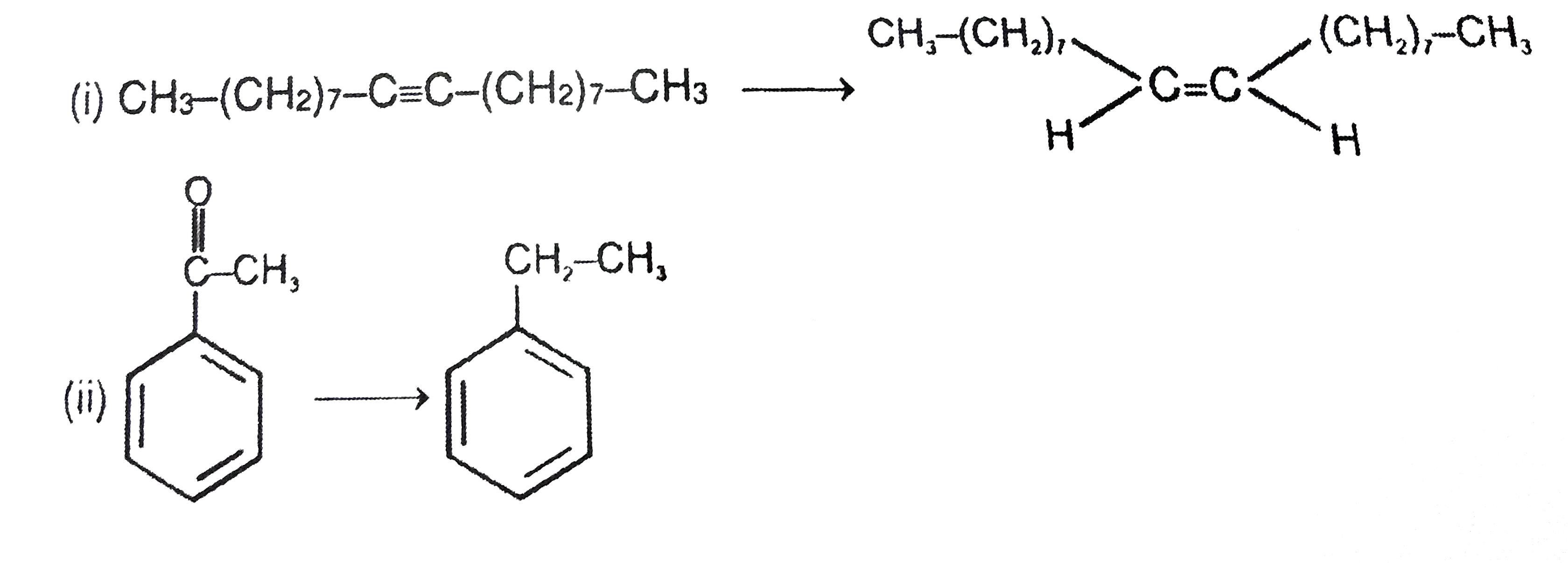In kharash effect,reaction follows
Free radical substituion
Electrohilic addition
Free radical addition
Nucleophillic addition
The correct Answer is:3
To solve the question regarding the Kharash effect and the mechanism it follows, we can break it down into a step-by-step explanation.
1. Understanding the Kharash Effect:
- The Kharash effect refers to the addition of HBr to alkenes in the presence of peroxides, which leads to the formation of products that follow the anti-Markovnikov rule. This means that the bromine atom attaches to the less substituted carbon atom of the alkene.
2. Identifying the Reaction:
- The reaction involves an alkene, specifically propene (CH3-CH=CH2), and HBr in the presence of a peroxide (like benzoyl peroxide).
3. Mechanism Initiation:
- The reaction begins with the homolytic cleavage of the peroxide bond in benzoyl peroxide (C6H5-C(=O)-O-O-C(=O)-C6H5). This cleavage generates two benzoyloxy radicals (C6H5-COO•).
4. Formation of Free Radicals:
- The benzoyloxy radicals decompose to form phenyl radicals (C6H5•) and carbon dioxide (CO2). The phenyl radical is a key initiator in this reaction.
5. Reaction of Phenyl Radical with HBr:
- The phenyl radical (C6H5•) reacts with HBr to generate bromobenzene (C6H5Br) and a bromine radical (Br•).
6. Alkene Reaction with Bromine Radical:
- The bromine radical (Br•) then reacts with the alkene (CH3-CH=CH2). This can lead to two possible products:
- One product has the bromine atom added to the less substituted carbon (CH3-CH2-CH2Br).
- The other product has the bromine atom added to the more substituted carbon (CH3-CHBr-CH3).
7. Stability of Free Radicals:
- The product where the bromine is added to the less substituted carbon (resulting in a secondary free radical) is more stable than the product where bromine is added to the more substituted carbon (resulting in a primary free radical).
8. Final Product Formation:
- The stable secondary free radical then reacts with HBr again, leading to the final product, which is 1-bromopropane (CH3-CH2-CH2Br).
Conclusion:
The Kharash effect follows a free radical addition mechanism, resulting in the formation of products according to the anti-Markovnikov rule.
---
- The Kharash effect refers to the addition of HBr to alkenes in the presence of peroxides, which leads to the formation of products that follow the anti-Markovnikov rule. This means that the bromine atom attaches to the less substituted carbon atom of the alkene.
- The reaction involves an alkene, specifically propene (CH3-CH=CH2), and HBr in the presence of a peroxide (like benzoyl peroxide).
- The reaction begins with the homolytic cleavage of the peroxide bond in benzoyl peroxide (C6H5-C(=O)-O-O-C(=O)-C6H5). This cleavage generates two benzoyloxy radicals (C6H5-COO•).
- The benzoyloxy radicals decompose to form phenyl radicals (C6H5•) and carbon dioxide (CO2). The phenyl radical is a key initiator in this reaction.
- The phenyl radical (C6H5•) reacts with HBr to generate bromobenzene (C6H5Br) and a bromine radical (Br•).
- The bromine radical (Br•) then reacts with the alkene (CH3-CH=CH2). This can lead to two possible products:
- One product has the bromine atom added to the less substituted carbon (CH3-CH2-CH2Br).
- The other product has the bromine atom added to the more substituted carbon (CH3-CHBr-CH3).
- The product where the bromine is added to the less substituted carbon (resulting in a secondary free radical) is more stable than the product where bromine is added to the more substituted carbon (resulting in a primary free radical).
- The stable secondary free radical then reacts with HBr again, leading to the final product, which is 1-bromopropane (CH3-CH2-CH2Br).
The Kharash effect follows a free radical addition mechanism, resulting in the formation of products according to the anti-Markovnikov rule.
Topper's Solved these Questions
- HYDROCARBONSBOOK - AAKASH INSTITUTE ENGLISHCHAPTER - HYDROCARBONSEXERCISE - Assignment(Section - B) (Obejctive type question)
5 Videos
- HYDROCARBONSBOOK - AAKASH INSTITUTE ENGLISHCHAPTER - HYDROCARBONSEXERCISE - Assignment(Section - C) (Previous Years Questions)
60 Videos
- HYDROCARBONSBOOK - AAKASH INSTITUTE ENGLISHCHAPTER - HYDROCARBONSEXERCISE - Exercise
33 Videos
- HALOALKANES AND HALOARENES BOOK - AAKASH INSTITUTE ENGLISHCHAPTER - HALOALKANES AND HALOARENES EXERCISE - ASSIGNMENT SECTION -D
15 Videos
- HYDROGENBOOK - AAKASH INSTITUTE ENGLISHCHAPTER - HYDROGENEXERCISE - ASSIGNMENT (SECTION - D) (Assertion-Reason Type question)
15 Videos
Similar Questions
Knowledge Check
Kharasch effect operates in which of the following ?
ACH3CH2CH=CH2+HClBCH3CH2−CH=CH2+HBrCCH3CH=CH−CH3HBrDCH3CH2CH=CH2+HIAssertion: There is no cause-effect relation between action and reaction.
Reason: Action and reaction are not simultaneous force.AIf both assertion and reason are true and reason is the correct explanation of assertion.BIf both assertion and reason are true and reason is the not correct explanation of assertion.CIf assertion is true but reason is falseDIf both assertion and reason are false.
All the following are the effects of depletion of ozone layer, except
View SolutionDiscuss the effect of increase of pressure on the following reactions
N2O4(g)⇔2NO2(g)
View SolutionWhat would be the effect on the rate of reaction due to the four-fold increase in a reactant concentration, if the order of reaction were the following:
(a) Zero order , (b) First order
( c) 1/2 order , (d) Fourth order
View SolutionWhich of the following is least effective in photosynthesis
View SolutionThe correct increasing order of trans-effect of the following species is
View SolutionState the sources and effects of the following gases:
Carbon dioxide
View Solution

